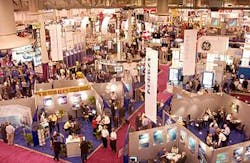Pushed by solidly higher market prices and a rich but remote resource base, the world's LNG industry sits at a pivotal point in its young history. That was the message of a packed general session at last week's Offshore Technology Conference in Houston.
Traditional LNG contract terms are changing with buyers demanding greater flexibility in volumes and delivery and with pricing in one region becoming more closely related to and affecting other markets. Traditional supply and demand relationships are breaking up as LNG consumption in North America and Europe has begun to drive supply projects at greater distances to commit resources to larger-capacity liquefaction plants.
All participants in the session agreed on the critical role of markets in North America and Europe in driving the growth in LNG demand. Steve J. Lowden of Marathon Oil Corp. noted that the projected supply-demand gap in the US equals the entire supply for Japan, currently the world's largest importer of LNG.
Meantime, an OTC panel touted the marine transport of compressed natural gas (CNG) as a promising solution for destranding natural gas in areas where reserves will not support the cost of LNG development.
The conference, the petroleum industry's biggest, ran May 3-6.
null
LNG changes and drivers
Rodney Schmidt, managing director in charge of the gas and power group at PFC Energy, said that in terms of global supply and demand, an abundant and increasing body of "discovered and unutilized gas" is pressuring companies that have this gas in their portfolios to move it as those companies continue to build up their reserve bases.
But "they wouldn't do that without demand." Increasing gas use throughout the world, especially for electric-power generation, is playing a great part in both developed and developing markets, he said. In addition, liberalization is opening many markets, most importantly in Europe, fueling demand for gas.
The "very important need and call on LNG," Schmidt said, however, is in North America. Traditional supply basins there are "mature, and demand has caught up with supply potential."
Moreover, demand exists on both North American coasts with important implications for supplies from both the Pacific Basin and the Atlantic Basin. This prospect raises fundamental questions about how to get LNG into this market, how many terminals will be needed and where will they be sited, and, finally, what will be the effect on natural gas prices locally and on LNG prices worldwide, he said.
Traditional long-term contracts, said Schmidt, are "bulletproof." But we are seeing terms in newer contracts changing: Buyers are asking for and getting greater flexibility in volume offtake "either in commitment or in timing and structure of terms."
He said pricing structures are under pressure as well, especially from "indexation": Rather than its traditional price indexing to crude oil, LNG is more often now being indexed to natural gas pricing in such places as the US Henry Hub as LNG penetrates further into Europe and North America.
Suppliers are competing to place their gas and building strategies around particular markets. Overall, Schmidt notes that the LNG industry and its related businesses "are changing fundamentally. Some companies are trying to enter markets they have never before served and exposing their balance sheets to new capital risks for bigger projects to move LNG."
And he pointed that in 2001-10, among only the five "supermajors," more than $50 billion has been committed to move LNG.
And finally, Schmidt noted that another factor that will affect price and volume movements in this time period is that many long-term contracts for Asia-Pacific-based LNG supplies will come up for renewal and could profoundly affect planned new and expanded capacity as well as amounts to be recontracted in 2010-15.
Growth history
What attracts BP PLC to the LNG business, said Douglas M. Rotenberg, president of BP Global LNG, is its consistent annual growth, especially when compared with other commodities in the industry.
"In this business," he said, while "[demand for] oil has grown at 0-2%[/year and] natural gas at 2-3%[/year], LNG shows a track growth of 7%[/year] and no signs of diminishing that growth.
"That's a fantastic pace [to entice companies to enter], and for players who are already there to play it bigger and harder." In 2003-04, that track record "of growth, profit, and safety" makes it an "interesting place for companies like BP to be."
Rotenberg asked the audience to remember only 10 years ago, 1993-94, when LNG was a niche market.
"Asian suppliers were going to Asian markets, Algerian supplies were going west of [the] Suez [Canal], with a little to the US and rest going to Europe," he said. The US Henry Hub price was at $1.50/Mcf and even down to less than $1/Mcf. "These were terrible macroeconomics for industry," he said, "but LNG was still growing at 7%[/year]."
And he said that, despite the perception of great financial risk, "projects in the Middle East and Asia continued to be developed in the mid and late 1990s."
The great change in this marketplace in 1993-2003, he said, was the perception of the need for this fuel.
Fundamental shifts in energy have occurred in three or four key countries, some of which already had "massive gas infrastructures that are very easy to tweak and accept large LNG imports.
"A huge prize was fought for and won between the cost of the gas in any resource country and the market value of that gas to the supplier," said Rotenberg.
But, he said, "What risks are the players in the LNG value chain—the resource holders, integrated company, shippers, terminals, and customers—willing to take to capture a disproportionate share" of the markets?
In the US, he said, where there is the "biggest call on gas," you encounter "all sorts of circular arguments: If gas prices reach $6[/Mcf], will demand be destroyed, and therefore we won't need it? Will it stay at $3.50 or $4[/Mcf] or some sort of happy medium price, and therefore we're likely to need this [supply] and a lot more? Nobody knows."
Rotenberg further said that the fundamental structures of the markets in the US, UK, China, India, and many of the countries are strongly underpinning demand for LNG.
By 2010, he said responding to a question, there will be "more of the same." Rotenberg called special attention to Qatar, which is ramping up a "massive growth plan."
At acceptable price levels, Qatari plants "are accessible to every single market in the world.
"In a quirk of geography, Qatar is equidistant from [the LNG terminal at] Lake Charles, La., and the US West Coast, assuming $3.50[/Mcf]" pricing, he said.
The US, according to Rotenberg, likely will build six new regasification terminals, and perhaps as many as eight.
And he noted the important expansions under way in Trinidad and Angola as sources for Atlantic Basin LNG. But, being from BP, he also called attention to Egypt, where LNG plans in 1999 were "a whisper" that will grow by 2006 to about 12 million tonnes/year of capacity.
Rotenberg also pointed out that the cost of LNG production and the cost of terminal and market access is roughly equal.
He said that the main difference—and what poses the most significant risk in any project—is shipping. An LNG train in Trinidad of, for example, 3-5 million tonnes/year requires two to three vessels/year to move LNG to the US. Qatar, on the other hand and assuming a similar sized train, would require 10-12 vessels.
But for Rotenberg and BP, the key value in the LNG train is upstream—in the resource, the gas. Using a gambling metaphor, he said the "molecules are in the house."
Focusing on the resource, he said, reduces the risk should one of the four or five elements in the LNG chain get out of balance.
CNG alternative
The CNG session represented the first OTC program dedicated solely to the emerging CNG transport and storage technology.
"LNG technology took about 50 years to become established, but now people are beginning to recognize that LNG doesn't solve all the gas supply problems around the world," said panel chairman Paul S. Britton, managing director of Houston-based EnerSea Transport LLC. "A new industry is being developed to fill that need," he said.
"Developers have been working on [CNG] concept systems over the last 5-10 years," said Britton. "This industry is really starting to take shape."
Breakthroughs in technology and advanced engineering designs as well as governmental support differentiate today's emerging CNG systems from earlier economic failures, panel members said.
EnerSea Transport is creating one of a number of CNG transport concepts under development. Britton indicated that an announcement concerning the first commercial CNG marine project utilizing its Volume Optimized Transport and Storage (Votrans) CNG system could be expected in late second or early third quarter of this year. He said feasibility studies are under way in South America and in Atlantic Canada and that first project approval is expected in first quarter 2005. "It [CNG marine transport] is something that's going to happen," he said.
Advantages, drawbacks
Because CNG is pressurized and does not have to absorb costs associated with liquefaction and regasification, it is more suited for midsize supply environments and markets within a 500-3,500 mile application. "About 2,500 miles is the 'sweet spot' for CNG," said panelist Matthew D. Palmer, project manager, CNG, for ChevronTexaco Global Gas, who emphasized the high correlation between investment cost and distance traveled.
Palmer said CNG can alleviate gas-constrained liquids production, can be capital cost-effective in deepwater applications, and can serve as an early production system for later LNG development. "CNG offers an attractive value proposition to everybody along the value chain, which is absolutely necessary for it to work," he said.
CNG also can be useful for fast-track projects, in transporting associated gas from remote areas, in deepwater areas unsuitable for pipelines, and in emerging gas economies, especially high-risk environments such as Libya, Britton said.
Along with its promise, however, are associated risks, said Matthew R. Simmons, president and CEO of Houston-based Simmons & Co. International, who reviewed the history of natural gas as a fuel and the problems inherent in its transportation, putting CNG in the context of gas price and demand. Instability of gas prices and the inability to predict what the prices will be is paramount among the risks, both for LNG and for CNG, he said. "It's difficult to pin down the cost of gas; it's a moving target," he emphasized.
He also said that 35% of wellhead gas used for LNG gets consumed by the time LNG is basically regasified, "so, if you're going to take one of these large-scale LNG projects and amortize it over 30 years, I would argue that the owner of that had better be sure they've lined up a 30 year supply. And it's not just a 30 year [1] bcfd, it's a 30 year 1.35 times that."
The cost to develop a usable gas supply also is on the rise, he said. Even though many in the industry believe LNG transportation costs will decrease with the learning curve, "no one mentions that the cost of steel would triple," which would increase the cost of LNG terminals and could double or triple the cost of offshore platforms, Simmons said.
"There isn't, in my opinion, any silver bullet," he added, saying that all sources have to be tried. "Never put all your energy eggs in one basketU. The role of CNG is not the answer, but it's an important additional answer. The promise is great, the risk is awful, and everything has to work," he said, including conventional natural gas, deepwater gas, gas tainted by impurities, coalbed methane, coal gasification, LNG, and now CNG, which can be added "as one of the real bullets to make this thing work."
Company support
ChevronTexaco's Palmer agreed that there are still some risks: that falling LNG costs could erode CNG's niche, that steel is costly—"likely a temporary blip," that financing of the initial ships would be difficult because applications first would have to be proved, particularly loading and unloading, which are dynamic rather than static and need more development.
However, he added: "We don't think this is something that is going to be prohibitive."
On the positive side, Palmer said that 80-90% of assets are redeployable, which changes the risk factor; that regulatory issues are being addressed; and that although there is a public perception of CNG as a danger, CNG actually would eliminate energy footprints, and companies could carve the message in a positive way to overcome public misconceptions and keep the momentum going.
Palmer said ChevronTexaco made a decision a couple of years ago to place a major focus on natural gas and commercialize its stranded gas, which would be critical to the strategy of the company's business plan. "ChevronTexaco believes it is not a question of 'if' CNG will come together but 'when and how,'" and it will probably be sooner rather than later, he added.
null
Regulatory momentum
Regulation follows innovation, said William J. Sember, vice-president for energy development at the American Bureau of Shipping, which currently is building a regulatory framework for CNG carrier safety. He said the standards are not complete, but ABS has developed guidelines for CNG containment systems and the hull propulsion system and marine system, which he said were "fairly well in place"—all issues that had to be addressed in the early stages of development.
ABS has announced the release of its guidance notes for building and classing ships carrying CNG to assist designers and operators on practical applications. Building on the International Gas Code of the International Maritime Organization, the guideline identifies acceptable methodologies for vessels carrying CNG, which is transported at pressures of 150-250 bars.
ABS is using existing industry standards and those of other agencies as a starting place for its CNG standards and inspection criteria. There currently are at least five different concepts for CNG delivery in various degrees of design approval, he said.
About 80-90% of CNG project investment is in the ship, Sember said, and consequently he advised CNG investors to put enough money up front in the design, which normally is only 5% of cost, because "the design might have 70% of influence on the project."
Sember, in an aside about other carriers that move natural gas, said there are 150 LNG carriers now in operation, 50% of which are more than 10 years old, and 40% probably over 20 years old. However, there are 60 LNG carriers now under contract and 60-100 more are predicted to follow those. Also, 125 oil FPSOs (floating production, storage, and offloading vessels) are operating. "So you can see there are big changes taking place in the energy business right now."
CNG R&D testing center
Rounding out the OTC panel was Axel Meisen, president and vice-chancellor of St. Johns, Newf.-based Memorial University of Newfoundland, home of the new Centre for Marine CNG—(CMCNG) the world's first research and development center for large-scale CNG marine transport and storage technology. Nine industry companies, including Maritimes & Northeast Pipeline, are sponsoring the world-class, not-for-profit research and testing center in cooperation with the university, ABS, the Gas Technology Institute, and the Province of Newfoundland and Labrador Mines and Energy.
In addition to industry membership and support, the center has a Canadian government-funded $6 million (US) for an initial 5 year program. The center will serve as a facility for testing CNG transport and storage components and as a forum for international CNG standards development (although it will not itself set those standards, Meisen said). CMCNG has a large-scale motion table pitch and roll simulator to test the effect of shipboard motion and other facilities for gas analyses and for testing and modeling dynamic loading and offloading operations as well as chilling and heating processes.
Meisen said the center would provide its first forum for information exchange June 22-24 in St. Johns.


